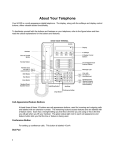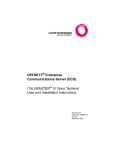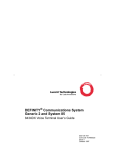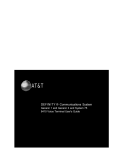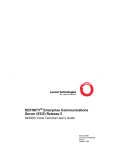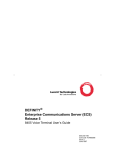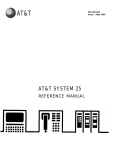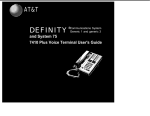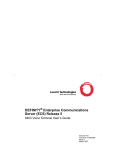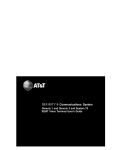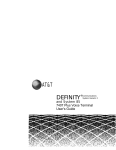Download AT&T Definity 7401 User`s guide
Transcript
AT&T DEFINITY ® Communications System Generic 1 and Generic 3 and System 75 7401 Plus Voice Terminal User's Guide NOTICE While reasonable efforts were made to ensure that the information in this document was complete and accurate at the time of printing, AT&T can assume no responsibility for any errors. Changes or corrections to the information contained in this document may be incorporated into future issues. TO ORDER COPIES OF THIS DOCUMENT Contact: AT&T Customer Information Center 2855 North Franklin Road P.O. Box 19901 Indianapolis, Indiana 46219 1-800-432-6600, In Canada: 1 800-255-1242 Document No. 555-204-740 Order: Issue 2, April 1992 For more information about AT&T documents, see Business Communications Systems Publications Catalog (555-000-010). HEARING AID COMPATIBILITY This equipment is compatible with the inductively coupled hearing aids prescribed by the Federal Communications Commission (FCC). Prepared by AT&T Technical Publications Department Middletown, New Jersey 07748 ©1992 AT&T All Rights Reserved Printed in USA Contents Your 7401 Plus Voice Terminal 1 What the Features Do 3 How to Use the Feature Directory 5 How to Use the Features 6 Key Words 6 Handset Tones 6 Special Instructions 6 Troubleshooting 7 Quick Reference Lists Abbreviated Dialing (AD) Answering or Placing a Second Call Automatic Callback Call Forwarding All Calls Call Park Call Pickup Conference Drop Hold 7 8 9 10 11 11 12 13 13 13 Last Number Dialed Leave Word Calling Message Priority Calling Select Ring Send All Calls Transfer Voice Message Retrieval 14 14 15 15 16 16 17 17 Tones and Their Meanings 19 Ringing Tones 19 Handset Tones 19 Troubleshooting System 75 Version Notes Key Words to Know 20 21 22 Quick Reference Lists i Your 7401 Plus Voice Terminal The 7401 Plus voice terminal has an innovative design to make it easy to use the many features of the AT&T DEFINITY® Communications System or System 75. Familiarize yourself with your voice terminal, shown in Figure 1 and explained below. Figure 1. 7401 Plus Voice Terminal Starting at the top of Figure 1 and continuing clockwise: Handset For placing and receiving calls (also known as the receiver). In most cases, you must lift the handset (go off-hook) before you can use a feature. Feature Directory A quick reference list of 12 voice features available on your voice terminal, including each feature name and its corresponding 2-button dial code. Speakerphone/headset jack This jack is used for connecting an external speakerphone (such as an S101A or S201A Speakerphone) or a headset adapter (such as a 500A Headset Adapter) to your voice terminal. The jack is labeled (on back of voice terminal) Line jack (on back of voice terminal) This jack is used for connecting a line cord to your voice terminal. The jack is labeled "LINE." Dial pad The standard 12-button pad for dialing telephone numbers and accessing features. Feature button A special button used for accessing the 12 features listed on the Feature Directory. (This button will be shown as [ Feature ] in the remainder of this booklet.) 1 Feature/call activity light A green light which goes on steadily when you press [ Feature ]. Also, it flutters when you have an incoming call or when you put a call on hold, and flutters intermittently when you use the Select Ring feature. Handset jack This jack is for connecting a handset to your voice terminal. The jack is labeled (on back of voice terminal) Message light A red light which lights steadily when a message has been left for you. Ringer volume control A sliding control to adjust the volume of the ringer. Slide it up (away from you) for a louder ring, down (toward you) for a quieter ring. (on back of voice terminal) 2 What the Features Do Below is a listing of many commonly used features and a description of how to use them. Note: You will have the Conference, Drop, Hold, Message, Select Ring, and Transfer features. In addition, you may have many of the other features listed here; your System Manager can advise you. Abbreviated Dialing (AD) Allows you to store selected telephone numbers for quick and easy dialing. Each number can be a complete or partial telephone number, an extension number, or a feature or trunk code. Abbreviated Dialing offers 4 possible types of lists– personal, group, system, and enhanced, and you can have a total of 3 out of the 4 lists. Numbers on a personal list are programmable by you; numbers on all other lists are programmable only by the System Manager. Use as a timesaver for dialing frequently called, lengthy, or emergency numbers. Answering or Placing a Second Call Allows you to answer or place a second call when you are already on a call. Use to avoid missing important calls or to make another call to get information you need for your current call. Note: Incoming second calls may be limited to priority calls depending on how your system is administered; see your System Manager. Automatic Callback Sends you a special 3-burst ring indicating that a previously busy or unanswered extension you dialed is now available. Use to avoid constant redialing when you wish to speak to someone who is frequently busy on the telephone or in and out of the office. Note: Can be used only for extensions, not outside numbers. Call Forwarding All Calls Temporarily forwards all your calls to another extension or to an outside number, depending on your system. Use when you will be away from your voice terminal and you want your calls to be forwarded to a telephone number of your choice. Call Park Puts a call on hold at your voice terminal, for retrieval at any extension. Use when you need to go elsewhere to get information during a call, or whenever you wish to complete a call from a different location. Also, if the call received is for someone else, use it to hold the call until the called party can answer it from the nearest available voice terminal. Call Pickup Lets you answer a call at your voice terminal for another extension in your pickup group. Use when you wish to handle a call for a group member who is absent or otherwise unable to answer. Note: You can only use this feature if you and the called party have been assigned to the same pickup group by your System Manager. 3 Conference Allows you to conference up to 6 parties on a call (including yourself) so that you can conduct a 6-way discussion. Use to set up time-saving conferences, or to spontaneously include an additional party important to a conversation. Note: If you have both an active call and a call on hold, you must terminate one of the calls before you can use Conference. Drop Drops the last party from a conference call. Use when you want to remain connected to the other parties. Hold Puts a call on hold until you can return to it. While a call is on hold, you can answer an incoming call or leave your voice terminal to perform another task. Use when you have a call that you don’t wish to drop, but which you have to interrupt briefly to do something else. Last Number Dialed Automatically redials the last extension or outside number you dialed. Use to save time in redialing a busy or unanswered number. Leave Word Calling Leaves a message for another extension to call you back. The called party will be able to dial message service (for example, attendant, AUDIX, covering user, etc.) to retrieve a short, standard message which gives your name and extension, the date and time you called, and the number of times you called. Use whenever you wish to have someone call you back; it will help cut down on repeated call attempts. Message Your Message light goes on when a caller has left a message for you. You can then follow your System Manager’s local message retrieval procedures to get your message. Priority Calling Allows you to call an extension with a distinctive 3-burst ring to indicate that your call requires immediate attention. Use when you have important or timely information for someone. Select Ring Allows you to choose your own personalized ring pattern for your voice terminal from among 8 available patterns. Use to help distinguish you incoming calls from those of other nearby voice terminals. Send All Calls Sends all your calls to the extension of a person designated by your System Manager to answer them when you cannot (perhaps a secretary or receptionist). Use when you will be away from your desk for awhile, or when you do not wish to be interrupted by telephone calls. Transfer Transfers a call from your voice terminal to another extension or outside number. Use when your caller needs to speak further with someone else. Note: Calls from an outside number to your voice terminal can be transferred only to an extension, not to another outside number; also, if you have both an active call and a call on hold, you must terminate one of the calls before you can use Transfer. Voice Message Retrieval Gives you messages (via computerized voice) left for you through Leave Word Calling or as entered by a covering user. If authorized by your System Manager, you may also retrieve messages for one or more of your co-workers. Use to hear all messages received while you were away. 4 How to Use the Feature Directory The Feature Directory, shown in Figure 2, provides a convenient quick reference list for 12 features which can be accessed by first pressing [ Feature ] and then pressing the corresponding entry number (1-9 and 0) or character (# and *) on the dial pad. For example, to put a call on hold, you would press [ Feature ], then [ # ]. And to set up a conference you would begin by pressing [ Feature ], then [ 8 ]. The green light next to [ Feature ] goes on steadily when the button is pressed to let you know that your dial pad is now in the feature selection state. Your Feature Directory will look like the one shown in Figure 2: If entries F1-F7 are blank, your System Manager may assign features to them, and you can write or type in the name of the features assigned. Feature Directory F1 F2 F3 F4 F5 F6 F7 F8 Conference (F8, dial party, F8) F9 Transfer (F9, dial party, F9) F0 Drop (Disconnect last party) F# Hold (Press switchhook to return) F* Select Ring (Press Feature to store) Press Feature button, then dial pad button Figure 2. Assignable Feature Directory The last 5 features on the Feature Directory are fixed: F8 F9 F0 F# F* Conference Transfer Drop Hold Select Ring Note: You are not limited to the 12 features shown on your directory. All other features available with your DEFINITY® Communications System Generic 1 or System 75 can be accessed by simply dialing a 1-, 2-, or 3-digit feature code, without using [ Feature ]. Your System Manager can supply those codes for you. 5 How to Use the Features The procedures which follow give short, step-by-step instructions for using each feature. For your convenience, features are listed alphabetically. Key Words You will see these two terms used regularly in the procedures: entry number A number from 1-9 and 0, corresponding to the first 10 entries on the Feature Directory. Each of these numbers is dialed in conjunction with [ Feature ] to access an assigned feature. flash the switchhook To press and then release the button under the handset (receiver). This button is the switchhook. Note: If you are using optional adjunct equipment, such as a speakerphone, connected to your voice terminal, you can also "flash the switchhook" by turning the adjunct equipment off and then back on. For a list of other glossary terms, see the chapter titled Key Words to Know. Handset Tones The tone that appears in brackets after a step, such as [dial tone], indicates what you should hear from your handset after successfully performing that step. For a list of tones and their meanings, see the section titled Tones and Their Meanings. For a list of glossary terms, see the section titled Key Words to Know. Special Instructions The first time you use these procedures, you will need to customize them for yourself by obtaining the following information from you System Manager: ● To the right of each feature name is a box. For each feature that you have on your Feature Directory and any other feature that has been assigned to you, mark a [ ✔ ] in the blank box as a reminder. (Answering or Placing a Second Call, Conference, Drop, Hold, Message, Select Ring, and Transfer are already marked for you.) 6 ● To operate a feature, you must have the handset off-hook (removed from the cradle of the voice terminal) unless otherwise noted. Any feature not listed on your Feature Directory can be activated or canceled by dialing a 1-, 2-, or 3-digit feature code. In the blanks provided within the procedures, write in the assigned code numbers. As you operate the features assigned to your voice terminal, keep in mind the following general rules. ● Follow carefully all the steps listed in the procedure for the particular feature you are using. ● If you receive an intercept tone (high-pitched, alternating high and low tone) while attempting to operate any feature, you have taken too much time to complete a procedural step or have made a dialing error. Hang up, get dial tone, and begin again at Step 1. ● Step 1 in most procedures gives you two options. Follow the first option if the named feature is listed on your directory; follow the second option (in gray type) if it is not. ● System 75 is available in more than one version. Some features, such as Abbreviated Dialing, Call Forwarding All Calls, Last Number Dialed, and Priority Calling operate slightly differently with Version 1, and possibly Version 2, than they do with later versions. If you are using Version 1 or 2 of the System 75 software, you should check the section titled Troubleshooting later in this guide before you use you use any of these 4 features. Troubleshooting Later in this guide you will find a short section on troubleshooting. Use the procedures listed here for problems that you may have in using your voice terminal. Quick Reference Lists At the back of this booklet is a set of quick reference lists. Use them to record your feature codes and trunk codes, Abbreviated Dialing personal list items, and message and attendant extensions. Once you have completed the lists, remove the page from the booklet (tear along the perforation), and keep the lists near your voice terminal. 7 Abbreviated Dialing (AD) To program/reprogram an AD entry on your Feature Directory Note: AD entry must first be assigned to your directory by your System Manager. 1 On a separate sheet of paper, jot down the outside numbers, extensions, and/or feature codes you want to store as AD entries Note: Each AD entry will hold one complete phone number or feature code. 2 [dial tone] Pick up handset 3 Dial Program code [dial tone] 4 Press [ Feature ], then the entry number for the AD [dial tone] entry you wish to program ● 5 For example, to store a number in AD entry F3, press [ Feature ], then [ 3 ] Dial outside number, extension, or feature code you want to store (up to 24 digits) Note: If you are storing an outside number, be sure to include a trunk code, if applicable. 6 Press [ # ] 7 Hang up ● To place an AD call from your Feature Directory 1 Be sure to write the name of the AD party (or feature) on your Feature Directory Press [ Feature ], then the entry number for the AD entry you wish to call [ringback tone] ● To program or reprogram a personal list item [confirmation tone] then [dial tone] For example, to call the number stored as AD entry F3, press [ Feature ], then [ 3 ] 1 On a separate sheet of paper, jot down the outside numbers, extensions, and/or feature codes you want to store as items on your personal list(s) (see example to the left) Note: Each phone number or feature code is stored as a separate item. 2 Pick up handset [dial tone] 3 Dial Program code [dial tone] 4 Dial Personal List number (1, 2, or 3) [dial tone] 5 Dial list item (1, 2, 3...) [dial tone] 6 Dial outside number, extension, or feature code you want to store (up to 24 digits) 8 7 Press [ # ] [confirmation tone] then [dial tone] Note: Repeat Steps 5-7 if you want to program additional items on the same list. Hang up and begin again at Step 1 if you want to program items on another personal list. 8 Hang up ● To place a call from a list (personal, system, group, or enhanced) 1 Record the personal list item on the Abbreviated Dialing list in the back of this booklet. Dial appropriate List code: ● List 1 ● List 2 ● List 3 [dial tone] or Press [ Feature ], then the appropriate entry number (if you have a list code programmed as a Feature Directory entry) 2 Dial desired list item (1, 2, 3...) [ringback tone] Note: Keep your own personal lists in the back of this booklet; system, group, and enhanced lists are available from your System Manager. Answering or Placing a Second Call To end first call and answer second call 1 ✔ Ask first caller to hang up, then flash the switchhook ● Second call is connected Note: Depending on how your system is administered, the incoming call may be limited to priority calls. Check with your System Manager. To put first call on hold and answer second call 1 Press [ Feature ], then [ # ] ● 2 First call is put on hold Flash the switchhook ● Second call is connected 9 To return to first call 1 Complete second call or put it on hold 2 Flash the switchhook ● First call is reconnected Note: By repeatedly using hold, you can toggle back and forth between calls. To put first call on hold and place a second call 1 Press [ Feature ], then [ 9 ] ● [dial tone] First call is put on hold Note: Pressing [ Feature ], and [ 9 ] instead of [ # ] gives you the dial tone needed to place the second call. 2 Dial second call To put second call on hold and return to first call 1 Press [ Feature ], then [ # ] ● 2 Second call is put on hold Flash the switchhook ● First call is reconnected Automatic Callback To automatically place another call to an extension that was busy, did not answer, or returned a call waiting ringback tone Note: You can do this only if Automatic Callback is assigned to your Feature Directory. 1 Press [ Feature ], then the Automatic Callback entry number (during call attempt) [confirmation tone] 2 Hang up ● You will get a 3-burst priority ring when the extension you attempted to call becomes available Note: After you activate Automatic Callback, the system monitors the called extension. That extension becomes available after the called party completes a call. 3 Lift handset when you hear priority ring ● A call is automatically placed to the extension, which receives regular ringing Note: Automatic Callback is automatically canceled after 30 minutes or if the callback call is unanswered. 10 To cancel Automatic Callback 1 Press [ Feature ], then the Automatic Callback entry [dial tone] number again Call Forwarding All Calls To temporarily redirect all calls to an extension or outside number of your choice 1 Press [ Feature ], then the Call Forward entry number or Dial Call Forward code [dial tone] 2 Dial extension or number where calls will be sent [confirmation tone] Note: Some voice terminals have restrictions on where calls can be forwarded (see your System Manager). 3 Hang up Note: You may hear a ring-ping tone from your voice terminal as each call is forwarded. To cancel Call Forwarding 1 Press [ Feature ], then the Call Forward entry number again or Dial Call Forward Cancel code [confirmation tone] ● Your calls will now ring at your own voice terminal Call Park To park a call at your extension (for retrieval at any extension) 1 Press [ Feature ], then [ 9 ] 2 [dial tone] Press [ Feature ], then the Call Park entry number or Dial Call Park code [confirmation tone] 3 Press [ Feature ], then [ 9 ] again ● Call is parked at your extension 4 Hang up 11 To return to a call parked at your extension 1 Press [ Feature ], then the Call Park entry number [confirmation tone] or Dial Answer Back code [dial tone] 2 Dial your own extension number [confirmation tone] ● To retrieve a call parked at another extension You are reconnected to call 1 Dial Answer Back code [dial tone] 2 Dial extension where call is parked [confirmation tone] ● You are connected to call Note: If you receive intercept tone, parked call has been disconnected or retrieved by someone else. Call Pickup To answer a call placed to a member of your pickup group when your voice terminal is idle 1 Press [ Feature ], then the Call Pickup entry number To pick up a call when you are already active on another call 1 Note: Depending on how your system is administered, you may not be able to do this procedure on your voice terminal. See your System Manager for more details. or Dial Call Pickup code ● You are connected to ringing call Press [ Feature ], then [ # ] ● Present call is put on hold ● Call activity light flutters 2 Press [ Feature ], then the Call Pickup entry number or Dial Call Pickup code ● You are connected to ringing call Note: To return to held call after completing present call, flash the switchhook. 12 ✔ Conference To add another party to a call (for a total of up to 6 parties) 1 Press [ Feature ], then [ 8 ] ● [dial tone] Present call is put on hold 2 Dial number of new party and wait for answer Note: You can privately discuss the call with the new party at this time; if no answer or busy, flash the switchhook to return to held call. 3 Press [ Feature ], then [ 8 ] again To drop a party ● All parties now connected ● Repeat Steps 1-3 for additional conference connections 1 Ask party to hang up You remain connected to other parties ● ✔ Drop To drop last party from conference call 1 Press [ Feature ], then [ 0 ] ● You remain connected to other parties Note: Parties other than last one added must hang up to be released from conference call. ✔ Hold To put a call on hold while you answer another call or perform some other task 1 Press [ Feature ], then [ # ] To return to held call 1 Flash the switchhook (or pick up handset if you hung up) ● Call activity light flutters; you may hang up if you wish 13 Last Number Dialed To automatically redial the last number you dialed 1 Press [ Feature ], then the Last Dialed entry number or Dial Last Number Dialed code Note: The redialed number can be an outside number (up to 24 digits), an extension, or a trunk or feature code. Leave Word Calling To leave a message after dialing an extension (when your call is not answered, you hear coverage or busy tone, or you have been put on hold) 1 Press [ Feature ], then the Leave Word Calling entry number [confirmation tone] ● Message light goes on at called voice terminal Note: You can do this only if Leave Word Calling is assigned to your Feature Directory. To leave a message without ringing an extension 1 Press [ Feature ], then the Leave Word Calling entry number or Dial Leave Word Calling code [dial tone] 2 Dial extension ● To cancel a Leave Word Calling message Note: You cannot cancel a message left for an AUDIX subscriber. [confirmation tone] Message light goes on at called voice terminal 1 Press [ Feature ], then the Leave Word Calling Cancel entry number or Dial Leave Word Calling Cancel code 2 Dial extension [dial tone] [confirmation tone] 14 Message To retrieve a message when your Message light is on ✔ 1 See your System Manager for instructions regarding your local message retrieval procedures Priority Calling To place a priority call (3-burst ring) 1 Press [ Feature ], then the Priority Calling entry number or Dial Priority Calling code [dial tone] 2 Dial the extension To change a regular call 1 Press [ Feature ], then the Priority Calling entry number into a priority call (when you hear a busy or call 2 Wait for called party to answer waiting ringback tone) ● If you still receive a busy tone or call waiting Note: You can do this ringback tone, wait a few minutes and try again only if Priority Calling is assigned to your Feature Directory. 15 Select Ring To select a personalized ring pattern 1 Press [ Feature ], then [ * ] (leave handset on cradle) 2 ● Green light flutters intermittently ● Voice terminal plays current ring pattern Adjust the ringer volume with the sliding ringer control on back of voice terminal if desired 3 Press [ * ] again to hear the next ring pattern Note: There are 8 different patterns; cycle repeats after the last pattern. 4 Press [ Feature ] when you hear the desired ring pattern ● Your new ring is set; selection process ends Note: If you receive a call, go off-hook, or lose power during selection, the process is interrupted and you must start again. Send All Calls To send all calls (except priority calls) immediately to coverage 1 Press [ Feature ], then the Send All Calls entry number [dial tone] or Dial Send All Calls code [confirmation tone] Note: When a call comes to your extension, call activity light will flutter and you may hear a ring-ping tone indicating that the call has been sent to coverage. To cancel Send All Calls 1 Press [ Feature ], then the Send All Calls entry number again [dial tone] or Dial Send All Calls Cancel code [confirmation tone] 16 ✔ Transfer To send present call to another extension or outside number 1 Press [ Feature ], then [ 9 ] ● 2 Present call placed on hold Dial number that call is to be transferred to [ringback tone] ● 3 [dial tone] Remain on line and announce call; if number dialed is busy or unanswered, return to held call by flashing the switchhook Press [ Feature ], then [ 9 ] again ● Call sent to dialed extension or number Note: Only calls from another extension can be sent to an outside number; you cannot transfer a call from an outside number to another outside number. 4 Hang up Voice Message Retrieval To retrieve your voice messages when your Message light is on 1 Dial the Voice Message Retrieval code [dial tone] 2 Press [ # ] [dial prompting] Note: If calling from someone else’s extension, do not press [ # ]; instead, dial your own extension number and your security code, if required. 3 Move through the messages with these dial pad buttons: (Press [ # ] to retrieve first message) [ # ] NEXT (read next message) [ 3 ] DELETE (erase from storage) [ 4 ] HELP (request assistance) [ 5 ] REPEAT (read message again) [ 8 ] CALL (call back named extension) Note: Whenever you call back an extension with [ 8 ], be sure to also delete the message by pressing [ 3 ] before you place the call; otherwise, the message will remain in storage. 4 Hang up to end Voice Message Retrieval 17 To retrieve voice messages for a co-worker 1 2 Dial Voice Message Retrieval Coverage code Dial co-worker’s extension [dial tone] [voice prompting] Note: If you receive an intercept tone, see your System Manager for further instructions. 3 Move through the messages with dial pad buttons previously listed 4 Hang up to end Voice Message Retrieval 18 Tones and Their Meanings Ringing tones are produced by an incoming call. Handset tones are those which you hear through the handset (receiver). Ringing Tones ● 1 ring — A call from another extension. ● 2 rings — A call from outside or from the attendant. ● 3 rings — A priority call from another extension, or from an Automatic Callback call you placed. ● ring-ping (half ring) — A call redirected from your voice terminal to another because Send All Calls or Call Forwarding All Calls is active. Handset Tones ● busy tone — A low-pitched tone repeated 60 times a minute; indicates the number dialed is in use. ● call waiting tone — One, two, or three beeps of high-pitched tone, not repeated; indicates an incoming call is waiting to be answered. Number of beeps designates the source: 1 for an internal call, 2 for an outside or attendant call, 3 for a priority call. ● call waiting ringback tone — A ringback tone with a lower-pitched signal at the end; indicates that the extension called is busy, but the called party has been given a call waiting tone. ● confirmation tone — Three short bursts of tone; indicates a feature activation or cancellation has been accepted. ● coverage tone — One short burst of tone; indicates your call will be sent to another extension to be answered by a covering user. ● dial tone – A continuous tone; indicates dialing can begin. ● intercept/time-out tone — An alternating high and low tone; indicates a dialing error, a denial of the service requested, or a failure to dial within a preset interval (usually 10 seconds) after lifting the handset or dialing the previous digit. ● recall dial tone — Three short bursts of tone followed by a steady dial tone; indicates the feature request has been accepted and dialing can begin. ● reorder tone — A fast busy tone repeated 120 times a minute; indicates all trunks are busy. ● ringback tone — A low-pitched tone repeated 15 times a minute; indicates the number dialed is being rung. 19 Troubleshooting Problem A feature doesn’t work as noted in the book. Solution 1 Reread the procedure and try again. 2 For many features you must lift the handset before you can use the feature. 3 Check with your System Manager to be sure this feature is administered on your voice terminal. 4 You may have an older version of the System 75 software so that some features may have slight differences from the procedures described in this guide. Check the section below on "Version Notes" for ways in which these features work differently. There are no Feature Codes (such as Call Forward code or Send All Calls code) written in the appropriate blanks in this guide. Problem There’s no dial tone. See your System Manager for a list of Feature Codes for features assigned to your voice terminal. Then, write the codes in this guide. Solution 1 Check with your System Manager to be sure your voice terminal is administered correctly. 2 Make sure that the handset and line cords at your voice terminal are securely connected at both ends. 3 Find a working voice terminal of the same type as your own. Unplug this voice terminal from its modular wall jack. Plug your voice terminal into that jack and check if it gets dial tone. 4 If your voice terminal still does not work, plug the working voice terminal (of the same type) into your modular wall jack. If the working voice terminal has dial tone, your own voice terminal is faulty. See your System Manager. 20 Solution Problem The telephone doesn’t ring. The lights do not go on next to the buttons. 1 Set the ringer volume to a higher level. 2 Place a test call from another extension to your extension. 3 Check the line cord to make certain that it is securely connected at both ends. 4 If there is still a problem, see your System Manager. 1 Check the line cord to make certain that it is securely connected at both ends. 2 If there is still a problem, see your System Manager. System 75 Version Notes If you have Version 1 or 2 of System 75, some features may work a little differently than noted in this guide. The following list explains the slight differences in these features. Note: If you are uncertain what version of the System 75 software your business is using, check with your System Manager. Feature System 75 Version Changes in Feature Operation If you are using Version 1 You can store up to 16 digits rather than 24 digits. If you are using Version 1 or 2 You cannot use an Enhanced List. Call Forwarding All Calls If you are using Version 1 or 2 You cannot forward someone else’s calls. Last Number Dialed If you are using Version 1 You can store up to 16 digits rather than 24 digits. Priority Calling If you are using Version 1 or 2 You cannot change a regular call into a priority call. Abbreviated Dialing 21 Key Words to Know activate To begin or turn on the operation of a feature. attendant The person who handles incoming and outgoing calls at the main console. AUDIX Audio Information Exchange, an optional voice mail and message service which provides coverage for calls to you by recording callers’ messages and reporting Leave Word Calling messages. coverage Automatic redirection of calls from an unanswered voice terminal to another voice terminal. Redirection could be to the extension of a receptionist, secretary, co-worker, AUDIX, or message center. A person who provides coverage is a covering user. DEFINITY Communications System Generic 1 and Generic 3 The AT&T switch to which you may be connected. (Your voice terminal may be connected to System 75 instead.) DEFINITY Generic 1, Generic 3, and System 75 are communications systems which transmit and receive voice and data signals for all communications equipment in your network. dial pad The 12 pushbuttons you use to dial a number and access features. enhanced list One of the 4 types of Abbreviated Dialing lists; programmable only by the System Manager (and available only with System 75 Version 3, DEFINITY Generic 1 and Generic 3). Contains telephone numbers useful to all system members, and stores each of those numbers as a 1-, 2-, or 3-digit list item. entry One of 12 spaces on the Feature Directory. At least 5 of these entries will already have features assigned to them; the remainder will be assigned features by your System Manager. entry number A number from 1-9 and 0, corresponding to the first 10 entries on the Feature Directory. Each number is dialed in conjunction with [ Feature ] to access an assigned feature. extension A dialing number of 1 to 5 digits assigned to each voice terminal connected to your DEFINITY Generic 1, Generic 3, or your System 75. feature A special function or service, such as Conference, Hold, Send All Calls, etc. Feature/call activity light The green light to the left of [ Feature ]. It goes on steadily when you use [ Feature ], flutters when you receive an incoming call or put a call on hold, and flutters intermittently when you use Select Ring. feature code A dial code of 1, 2, or 3 digits, which you use to activate or cancel the operation of a feature not listed on your Feature Directory. Feature Directory The list of features on your voice terminal just above the dial pad. Each feature is activated by pressing [ Feature ] and an entry number, and is assigned by your System Manager. The directory has a surface you can write on for labeling entries not preprinted with a feature name. 22 group list One of the 4 types of Abbreviated Dialing lists; programmable only by the System Manager. Contains telephone numbers useful to members of a specific group, and stores each of those numbers as a 2-digit list item. handset The handheld part of the voice terminal which you pick up, talk into, and listen from. Also known as the receiver. party A person who places or answers a call. personal list One of the 4 types of Abbreviated Dialing lists; programmable by the System Manager or by you, the user. Contains telephone numbers of your choice, and stores each of them as a single-digit list item. personal list item One of the 10 available slots on an Abbreviated Dialing personal list. The first nine personal list items are given digits 1 to 9, with 0 for the tenth item. pickup group A group of up to 25 voice terminal users who can answer calls for each other through the Call Pickup feature. Group members are determined by the System Manager and are usually located in the same work area or perform similar job functions. priority call An important or urgent call which sends a special 3-burst ring. program/reprogram To use your dial pad to assign a telephone number to an AD entry on your Feature Directory or to a personal list item for Abbreviated Dialing. public network The communications system that can be accessed by all telephone customers for local or long distance calling. retrieve To collect telephone messages with the Message or Voice Message Retrieval features. (Also, with Call Park, to resume a call from an extension other than the one where the call was first placed or received.) ringer The device that produces the electronic ringing sound in your voice terminal. stored number A telephone number which has been programmed and stored as a 1-, 2-, or 3-digit list item for use with Abbreviated Dialing. It can be a complete or partial telephone number, an extension number, or a feature or trunk code. Once programmed, a number can be accessed by first dialing the list, then the list item digit(s) under which it is stored. (Alternatively, if Abbreviated Dialing is on your Feature Directory, a number can be accessed by simply pressing [ Feature ], then dialing the appropriate entry number.) switch The device that makes connections for all voice and data calls for a network, and which contains software for features. Also known as a system, switching system, or PBX (private branch exchange). Your switch is either an AT&T DEFINITY Communications System Generic 1, Generic 3 or System 75. System 75 The AT&T switch to which you may be connected. (Your voice terminal may be connected to DEFINITY Communications System Generic 1 or Generic 3 instead.) System 75, DEFINITY Generic 1, and Generic 3 are communications systems which transmit and receive voice and data signals for all communications equipment in your network. 23 switchhook The button under the handset in the cradle of the voice terminal. system list One of the 4 types of Abbreviated Dialing lists; programmable only by the System Manager. Contains telephone numbers helpful to all system users, and stores each of those numbers as a 2-digit list item. System Manager The person responsible for specifying and managing the operation of features for all the voice and data equipment in your network. trunk A telecommunications channel between your switch and the public network. Trunks of the same kind connecting to the same end points are assigned to the same trunk group. trunk code A dial code of 1, 2, or 3 digits which you dial to access a trunk group to place an outside call. voice terminal A telephone equipped with an array of specifically designed features (for example, Feature button, Message light, etc.) and functional capabilities that distinguish it from a conventional telephone. 24 Quick Reference Lists Feature Codes Feature Code ABBREVIATED DIALING Feature Code CALL PICKUP List 1 LAST NUMBER DIALED List 2 LEAVE WORD CALLING List 3 cancel Program PRIORITY CALLING CALL FORWARDING ALL CALLS SEND ALL CALLS cancel cancel CALL PARK VOICE MESSAGE RETRIEVAL Answer Back Coverage




























